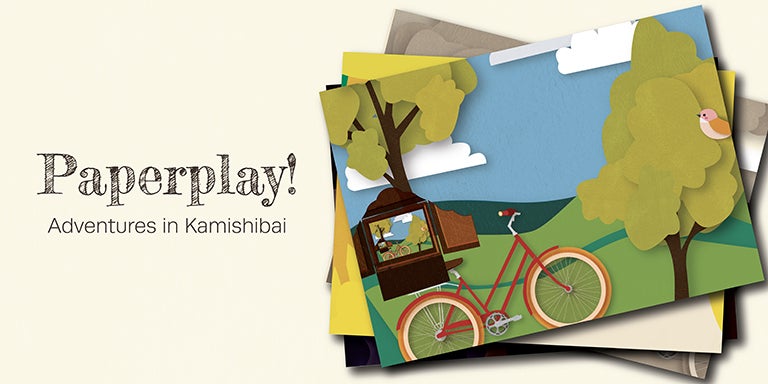Paperplay! Adventures in Kamishibai
Created by the Student Ensemble with Prof. Natsu Onoda Power
Paperplay, a series of short works created by student performer-designer-storytellers and GU Theater & Performance Studies Program Professor Natsu Onoda Power, is inspired by kamishibai, a style of Japanese street performance that uses illustrated paper placards. This immersive, ambulatory show inventively retools the pre-cinema form of kamishibai, when a solo performer would ride a bicycle around towns and then perform, stopping at street corners to mesmerize children with folk tales, intrigue grown-ups with pulp fiction, and sometimes sell candy. Join us for this solo and ensemble performance October 21-30, 2021 (showtimes below) that moves in and beyond the Davis Performing Arts Center, opening its 2021-22 Sweet 16 Anniversary Home Season, “Makers in the Space: Making Space,” programmed by Artistic Director Prof. Maya E. Roth.
As an ancient storytelling tool, the art of kamishibai is deeply rooted in cultural art and expression, and its various manifestations can be traced all through Japanese history. It began with the birth of emaki scrolls during 12th century e-toki (“picture deciphering”), eventually evolving into ukiyo-e (“pictures of the floating world”) during the Edo Period, and then tachi-e (“stand-up pictures”) during the Meiji period. Finally, from the 1920s to 1930s, kamishibai started to take form: kami meaning paper, and shibai meaning play or theatre.
The kamishibai man would travel from village to village, bag full of sweets and a wooden butai—half picture frame, half theatre stage—attached to the back of his bike. He would also bring along hyoshigi, wooden clappers used to attract the young audience members. After selling candy and waiting for the crowd to gather, the story would begin: the kamishibai man gracefully pulled each of the numbered and illustrated storyboards from the side, performed, slid it to the back of the stack, and then repeated. To ensure returning crowds, he would always stop at a cliffhanger point in the story, leaving audience members breathless and hungry for more.
In the present day, kamishibai has maintained its ability to capture the imagination of wide audiences, though it has transcended its cultural roots and is now performed in languages from all around the world. Schools in many countries have adopted the storytelling method for this reason, as it provides an integrated and versatile approach to learning through visual art. There are many different forms of kamishibai. Sometimes, the storyteller performs an already published story, while other times, they improvise and use audience participation.
Showtimes for this FREE performance include the following:
Thursday, October 21 – Saturday, October 23 at 7 p.m., with staggered group excursions
Sunday, October 24 at 2 p.m., with staggered group excursions
Friday, October 29 – Saturday, October 30 at 7 p.m., with staggered group excursions
Registration and masks required. To watch the Georgetown performing arts community and Prof. Natsu Onoda Power’s adventures in kamishibai, register for Paperplay on Eventbrite.
View the program for Paperplay.
Visit the GU Department of Performing Arts website at performingarts.georgetown.edu.
NATSU ONODA POWER specializes in adapting non-dramatic texts into new works of visual theater, and also directs. Original works (writing/ adapting/ directing) include Thumbelina at Imagination Stage; The Lathe of Heaven at Spooky Action Theater and Georgetown; Alice in Wonderland with National Players; Wind Me Up, Maria!: A Go-Go Musical at Georgetown University; Astro Boy and the God of Comics at the Studio Theater and Company One Theater, Boston. Other directing credits include Provincetown Tennessee Williams Festival; Olney Theater Center; the Studio Theatre; Baltimore CenterStage; Mosaic Theater, and Theater J. She is the recipient of two Elliot Norton Awards (for Outstanding Direction and Production Design), two Helen Hayes Awards (Outstanding New Adaptation and Outstanding Set Design), as well as a DC Commission in the Arts fellowship. Onoda Power holds a Ph.D. from Northwestern University, and is the author of God of Comics: Osamu Tezuka and the Creation of Post- World War II Manga (The University Press of Mississippi, 2009). She is a Professor of Theater and Performance Studies at Georgetown University.
GU THEATER & PERFORMANCE STUDIES PROGRAM
Prof. Derek Goldman, Ph.D., Director
Housed in the Davis Performing Arts Center, the Georgetown University Theater & Performance Studies Program features a nationally recognized faculty of leading scholar/artists and professional practitioners who offer a dynamic interdisciplinary major that emphasizes the interaction of artistic and analytic inquiry. The Program has rapidly attracted significant national attention for its distinctive curriculum, which integrates the political and international character of Georgetown, a commitment to social justice, and high-quality, cutting-edge production seasons, including world premieres. In 2012, Backstage selected the Program as one of the top five college theater programs outside of New York City.
DAVIS PERFORMING ARTS CENTER
Prof. Maya E. Roth, Ph.D., Artistic Director
Opened in November 2005 as Georgetown University’s first building designed for the arts, the Davis Performing Arts Center is the research, teaching, and public exchange laboratory for the Theater & Performance Studies Program and houses the administrative office of the Department of Performing Arts. Since its inaugural season, the Davis Center has hosted a thematically linked home season for the Theater and Performance Studies Program, featuring cutting-edge productions committed to diversity and artistic risk-taking. We have presented numerous new works and adaptations, DC premieres, bold re-imaginings of classics, important contemporary plays, and student-devised productions.
Our home season has engaged deep collaborations with nationally renowned artists (including Sojourn Theatre, Heather Raffo, The Neo-Futurists), acclaimed local companies (like Synetic Theater, Spooky Action Theater, a 15-year partnership with Arena Stage at the Mead Center for American Theater), local universities (e.g. Gallaudet University, University of Maryland), and frequent co-productions with Alumni (including LubDub Theatre Co., Swedian Lie, Isaiah M. Wooden) and GU’s student theater companies (including Black Theatre Ensemble, Mask and Bauble, and Nomadic Theatre). The Davis Center hosts annual residencies of the Music Program, the Laboratory for Global Performance and Politics, and the Dance Program.
